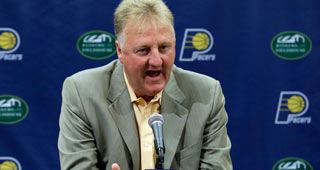The Indiana Pacers’ long, excessively deliberate signaled quest to improve their offense moved forward yet again hours before the draft when they traded the 20th overall pick and a future second rounder to the Brooklyn Nets for Thaddeus Young.
Young was re-signed by the Nets on a four-year, $50 million deal in the 2015 offseason and he has a player option in 2018. With the rising cap, this is a below market value for a 28-year-old starting caliber power forward.
In acquiring Young, the Pacers’ experiment with playing Paul George heavy minutes at power forward is over, as is the tenure of Ian Mahinmi. With Mahinmi expected to get a heavy raise in free agency and Myles Turner ready to start at center, it was inevitable for him to be gone this offseason.
Larry Bird has wanted the Pacers to play faster and Young allows them to do so. A starting five of Young, George, Jeff Teague, Monta Ellis and Turner will be a problem for teams on that front. The Pacers were ranked 11th in pace last season, jumping up from 19th on Bird’s directive.
Indiana’s success during the Paul George-era has been predicated on defense, they were still third last season, and that ranking will unquestionably fall this season with Young, Ellis and Teague all being below average for their position.
Young has the characteristics of a stretch-4 as he’s basically a small forward in the body of a modern power forward except he has regressed as a shooter since showing some promise early in his career. Young shot just 23.3 percent on 30 attempts from three this past season after attempting nearly 300 at 30.8 percent in his final season with the 76ers in 13-14. If Young can regain his shooting form with the Pacers and hit 33 percent of his attempts at a decent volume as he did in 14-15, you can then begin to see the formations of a nice offense.
Right now, the Pacers are built to play fast without the type of three-point efficiency we typically see from teams that use the blueprint.
The Pacers have had one of the league’s better track records in the draft, but the urgency of maximizing their window during George’s prime is dictating all decisions right now for this franchise.
Young makes the Pacers better in the short-term but in a rather insignificant way. If Indiana can trade away Ellis and replace him with a better defensive player and three-point shooter, then moving up into the top-4 of the Eastern Conference becomes a more realistic possibility.
Grade for Pacers: C+
Sean Marks inherited the NBA’s worst portfolio of assets when he became general manager and moving Young for the 20th overall pick and a future second rounder is a nice first step.
In no way did Young align with the Nets’ long-term plans as it will take several years for them to gather enough NBA quality players to even begin thinking about competing for a playoff spot.
Brooklyn also clears cap space for this offseason and since they aren’t likely to be anyone’s destination, Sean Marks now assumes the Sam Hinkie hardhat as salary dump facilitator and collecting future picks along the way to make up for what’s been lost with the Boston trade will continue indefinitely. With so many teams possessing cap space, a trade of Brook Lopez surely should be next up this summer.
Grade for Nets: A
The Celtics indirectly are involved as they get to swap picks with the Nets in 2017 and Brooklyn’s probable draft position worsens by dealing away Young. The Nets were going to be bad whether they kept Young or not and they’ll now be even worse.
Boston is drafting third overall owning Brooklyn’s pick outright and they almost certainly will be picking no worse than fifth in 2017 due to the pick swap.
Grade for Celtics: A



